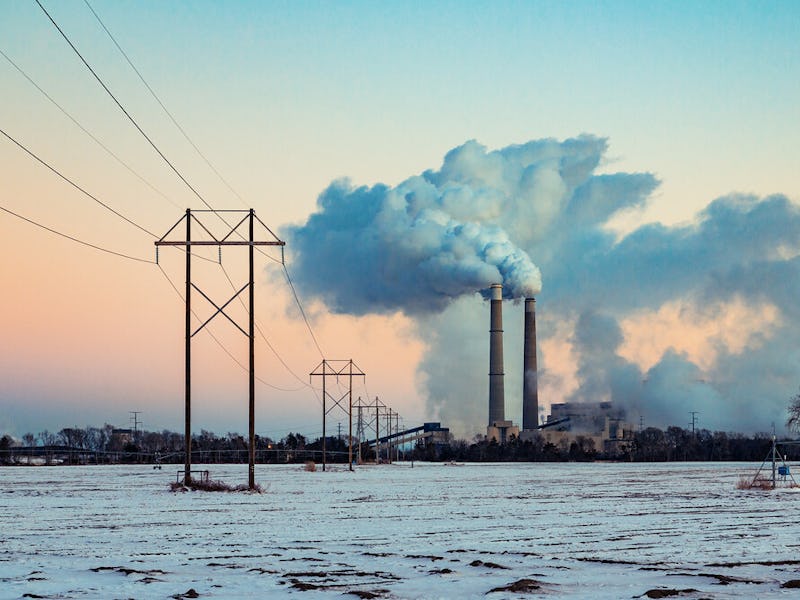2 Top US Health Organizations Are Filing a Lawsuit Against Trump's EPA
A new rule "will allow for an extraordinary amount of pollution."

On Monday at the White House during a talk on environmental leadership, President Donald Trump stated that a priority of his administration is to provide Americans with the “cleanest air and cleanest water on the planet.”
He delivered these remarks on the same day that two of the country’s leading health organizations, the American Public Health Association and the American Lung Association, announced they were filing a lawsuit on behalf of the American people to protect their access to clean air and clean water. Specifically, the lawsuit challenges the Environmental Protection Agency’s decision to repeal the Clean Power Plan (CPP) and replace it with the “Affordable Clean Energy” (ACE) rule.
The CPP, which was unveiled under President Barack Obama, set the first-ever national limits on carbon pollution from power plants and required states to implement plans to reduce carbon dioxide emissions by 2022. It also required the reconstruction of power grids to shift utilities away from coal and toward clean energy sources.
A coal-fired power plant located near Page, Arizona.
Under President Trump, the EPA has repealed the CPP in favor of the ACE rule, claiming that the CPP exceeded what the EPA is allowed to enforce under the Clean Air Act. The ACE rule, on the other hand, requests that states reduce emissions, but it sets no targets and includes no enforcement. Andrew Wheeler, the EPA administrator and a former coal lobbyist, says that the ACE will reduce carbon emissions and help the environment. He has also said that the new rule could lead to new coal plants.
Janice Nolen, the assistant vice president of national policy at the American Lung Association, tells Inverse that her organization “disagrees completely” with the idea that the CPP overstepped the EPA’s authority. She emphasizes that its advantage over the ACE rule was its focus on the entire system of energy — it required a reshaping of the system, but it also provided a toolkit for pursuing new ways of producing energy.
“We have seen long-term progress in clean air, but we are running up against a fundamental problem that is not going to go away, and that is climate change,” Nolen says. “The ACE rule that has just been published is not going to help us and we need to do more.”
Now, the American Lung Association and the American Public Health Association are asking the United States Court of Appeals for the District of Columbia Circuit to consider a petition asserting that the EPA, by repealing the CPP and finalizing the ACE, is not fulfilling the requirements of the Clean Air Act. It is not lawful, they claim, for the EPA to “use its legal authority in ways that will increase dangerous air pollutants and harm the health of Americans.”
"So it will not only allow carbon dioxide emissions to continue, it will allow for an extraordinary amount of pollution that can literally kill people in the interim."
“We are very concerned about the health effects,” Nolen says. “A lot of these power plants are creating emissions that are in the form of nitrogen oxides and sulfur dioxides that become particle pollution. Particulate matter is a lethal air pollutant.
“This rule will allow coal plants to continue to operate, and to operate more frequently. So it will not only allow carbon dioxide emissions to continue, it will allow for an extraordinary amount of pollution that can literally kill people in the interim.”
Nolen says that these pollutants disproportionately harm the people living close to these facilities, who are often times people of lower incomes and communities of color.
An early analysis of the ACE plan by the Trump administration found that replacing the CPP with the ACE would result in an additional 1,400 premature deaths per year. In May, the EPA introduced a new analytical model that reduced that number and changed the way the EPA calculates the health risks of air pollution.
Andrew Wheeler is the head of the EPA and a former coal lobbyist.
Meanwhile, a study produced by Harvard University, Syracuse University, and the research organization Resources for the Future, determined that the ACE rule would cause more carbon dioxide emissions than not implementing any rule:
Although the ACE reduces the emissions intensity of coal plants, it is expected to increase the number of operating coal plants and amount of coal-fired electricity generation, with 28% of model plants showing higher CO^^2 emissions in 2030 compared to no policy.
And despite President Trump’s claim that the United States has “the cleanest air we’ve ever had,” the reality is that we do not. The Obama administration set the record for the fewest air polluted days in 2016, and when President Trump took office in 2017, the number of bad air days per metro area increased by 20 percent. Furthermore, the ALA’s “State of Air” 2019 showed that from 2015 to 2017, more cities had high days of ozone and short-term particle pollution compared to the period from 2014 to 2016.
Now the Court must decide whether or not it will accept the petition for review.
Nolen expects other organizations will file similar lawsuits during the current 60-day opening until the opportunity to file closes. It’s likely that they will be able to submit a brief in the winter — or sometime next year. The process is long and arduous, and the Trump administration is not likely to back down.
“We are concerned about this administration because we have seen its efforts to change and weaken the Clean Air Act,” Nolen says. “They are changing the way that something has been interpreted for 40 years, and that is very, very worrying.”